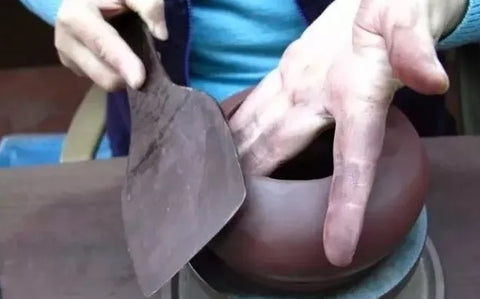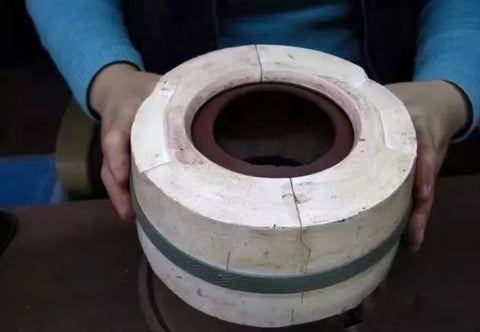Half-hand made Yixing teapot.
A "half-hand made" Yixing teapot refers to a teapot that is crafted with the assistance of a mold during the challenging and time-consuming body shaping process.
This intricate step is demanding not only for junior artists but also for seasoned masters, as it necessitates a keen aesthetic sense and extensive experience.
Even though a half-hand made pot involves the use of a mold during body shaping, it still requires the artisan's hands for every step of the process, mirroring the procedures employed in crafting a fully hand-made pot.
This hands-on approach continues until the teapot attains its fundamental teapot shape, and it remains a critical part of the production process throughout.

In the case of a half-hand made teapot, a mold is employed to achieve a perfectly round body shape efficiently. The mold streamlines the shaping process, ensuring precision in the teapot's overall form.
However, it's important to note that while the mold aids in achieving the desired body shape, there are numerous intricate details that still require meticulous handcrafting.
This includes working on junctions, creating holes for the handle and water pouring spout, and other fine details that contribute to the teapot's final design and functionality.

The Distinction Between Half-Hand Made and Fully Hand Made Yixing Teapots
The main reason why half-hand made teapots can be priced lower than their fully hand-made counterparts, even when crafted by the same artisan using the same clay material and shape, is the time and effort saved. The use of a mold streamlines the process while maintaining quality.
It's crucial to note that half-hand made teapots are not to be confused with chemical teapots, machine-made teapots, or grouting teapots, which can potentially pose health risks. We do not source or sell such teapots.
You have the freedom to choose between half-hand and fully hand-made teapots based on your preferences, budget, and requirements. When quality or health concerns arise, it's advisable to inquire with the seller for more details. Nevertheless, even half-hand made teapots should have a reasonable price that reflects their craftsmanship and materials.
Factors We Consider When Sourcing or Evaluating Yixing Teapots
When sourcing or evaluating Yixing teapots, we consider several key factors:
-
Appearance: This encompasses style (including vertical and horizontal alignment), color (natural or not), and any odors (natural, earthy, or otherwise). We also assess various design and craftsmanship details, from the exterior to the interior of the teapot. It's worth noting that odors from the packaging, such as the glue used in square boxes, can sometimes transfer to the teapot. However, these odors can be eliminated through a thorough cleaning process like boiling and brewing tea (not for consumption).
-
Certificate from the Author: We check for the presence of the author's stamp mark, which should appear on the certificate, the exterior bottom of the teapot, the interior of the lid, and the underside of the handle. This distinguishes authentic teapots from factory-produced ones bearing a generic "China Yixing" mark.
-
Water Flow: We assess the teapot's water flow, considering whether it is smooth and fast.
-
Tea Brewing and Temperature Maintenance: We evaluate how effectively the teapot brings out the essence of tea to enhance taste and flavor."
